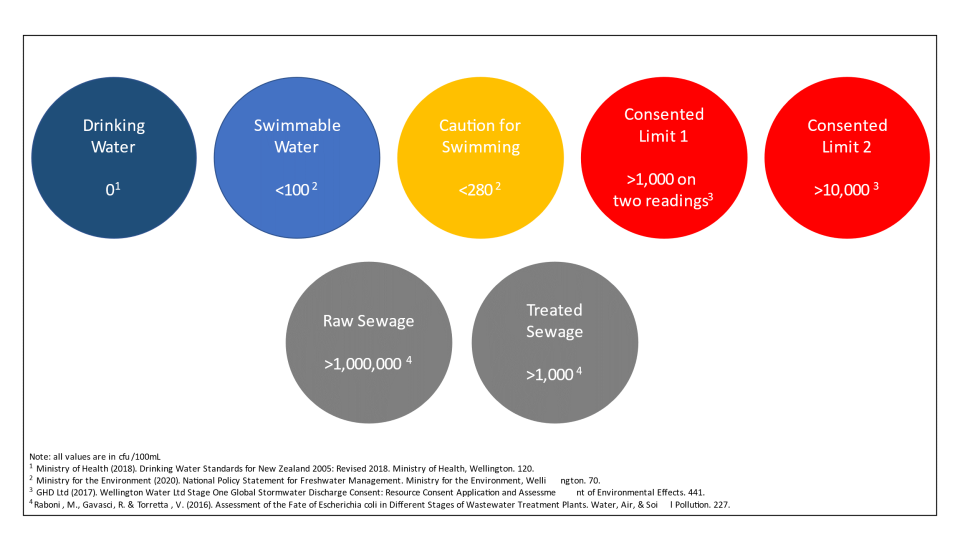Waiwhetu catchment sampling
The Waiwhetu Stream springs from the eastern hills near Taita and Naenae and flows southwards to join Te Awa Kairangi/Hutt River near its mouth. The stream network within the catchment is approximately 27km in length. The stream sustained iwi for centuries before the arrival of European settlers, with Owhiti Pā and Waiwhetu Pā being the most important Pā on the awa.
As the area was settled and developed, the stream underwent changes which were often disruptive of its natural state. In places the natural stream was straightened, later concrete channels were installed, vegetation cleared and the pressures of urbanisation impacted on stream health.
The stream is graded as Wai Kino, contaminated by human waste, in the Te Oranga Wai Mana Whenua assessment framework (2021). It is also recorded as Ngā Taonga Nui a Kiwa, a water body of most importance to Mana Whenua, in the Natural Resources Plan for the Wellington Region.
The Te Whaitua te Whanganui-a-Tara Implementation Programme (2021) has ranked a number of water quality indicators within the Waiwhetu Stream sub-catchment from A through to E, giving an indication of the current state of the freshwater. The Waiwhetu Stream has been graded an E for E.coli concentration, C for Copper, D for Zinc, and A for clarity. These values indicate that the quality of the water in this catchment is degraded and therefore work is needed to improve the water quality.
Seaview Wastewater Treatment Plant
The Seaview WWTP began operating in 1962 with preliminary treatment only, was upgraded to milliscreening in 1984 and full treatment was commissioned in March 2002. The liquid stream management consists of 1mm drum screens, primary sedimentation, contact stabilisation, and secondary clarification followed by UV disinfection. The WWTP treats sewage from Upper Hutt, Lower Hutt and Wainuiomata and handles over 50,000 m³/day predominantly of domestic origin, and also small volumes of trade waste.
During periods of sustained wet weather, secondary effluent flows in excess of the main outfall pipeline capacity are diverted to a 5,000 m³ storm tank. When the storm tank is full any excess flow is disinfected as it passes through the UV system and overflows adjacent to the effluent pumping station to an outfall in the lower Waiwhetu Stream.
Map Legend
Loading
Water quality routine sample testing - how it's reported
We take regular samples of water quality to look into the level of E.Coli for freshwater and Enterococci for marine waters, which indicate whether the water is safe for swimming and other recreational activities.
The way in which we test and classify when water is safe, or not safe depends on how the stream or waterway is classified (i.e. either as a ‘consented stormwater discharge’, or a Marine and Freshwater recreational area). Find out more about our reporting requirements below:
Consented stormwater discharge
The Waiwhetu Stream is a freshwater watercourse that is covered under a resource consent approved by the Greater Wellington Regional Council (GWRC) for stormwater discharge.
The consent requires us to monitor stream water quality on a monthly basis at two designated sites, Tilbury St and Rishworth St. The consent also requires us to undertake an investigation if the routine E.coli monitoring at either of these sites identifies a single result >10,000cfu/100mL or two successive monthly E.coli results >1,000cfu/100mL. These investigations are only initiated if the sample was not influenced by rainfall, which is cross checked with the rain gauge at Shandon Golf Club.
In addition to this, GWRC undertakes monthly Rivers Water Quality and Ecological (RWQE) monitoring at Whites Line East. There are no investigation triggers associated with this programme.
Marine and Freshwater Recreational Areas
Waiwhetu Stream and its mouth are not classified as a Marine and Freshwater Recreational Area
For areas classified as a Marine and Freshwater Recreational Areas, Enterococci sample readings equal to or less than 140 cfu/100 mL, or Equal to or less than an E.coli level of 260 cfu/100mL give a suitable for swimming classification. Where a Enterococci reading is greater than 140 / 100mL, or more than an E.coli level 260 cfu/100mL, the area is given a Caution Advised classification. Finally, where an Enterococci reading is more than 280cfu/100mL, or more than an E. coli level of 550 cfu/100 mL, it is given an unsuitable for swimming classification.
These classifications are recorded and reported by LAWA (Land, Air, Water Aotearoa) and made available through their website). The closest Marine and Freshwater Recreational Areas to the Waiwhetu Stream are Petone Beach and Sorrento Bay.
E.coli rule of thumb guide (In development - will be updated)

Report an issue
If you believe this relates to a specific consent, please reference that consent number
Hotline
Greater Wellington Regional Council Pollution Hotline
0800 496 734
